Historical Battles: The Battle of the Bulge
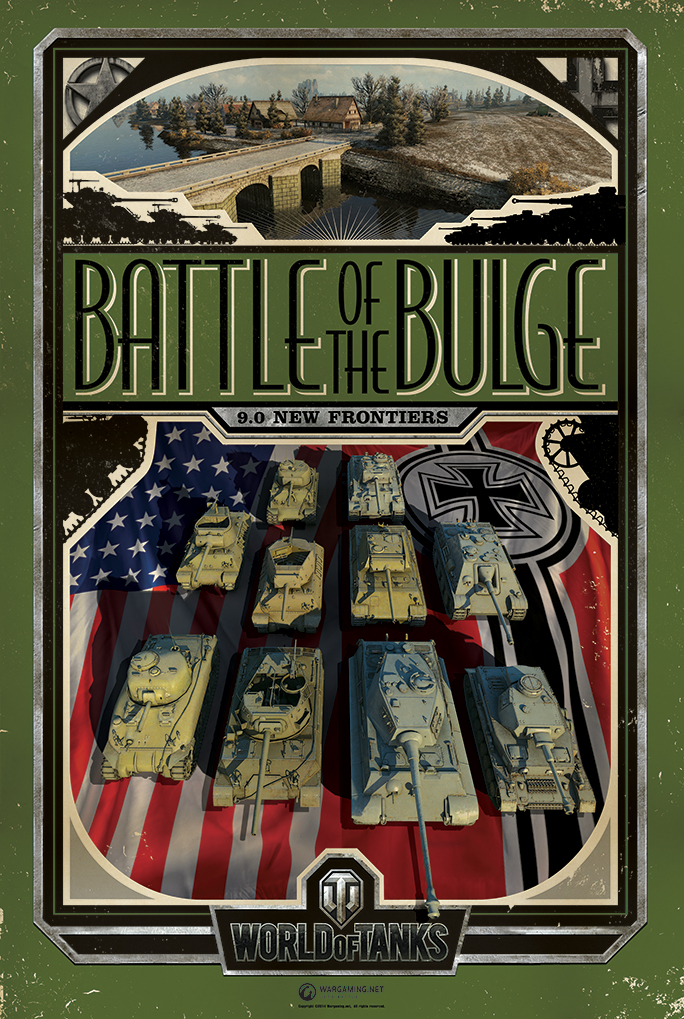
Combatants | History | Battle Mode
Combatants
Realizing that the Allied advance had slowed to wait for supplies from Antwerp, German Generaloberst Alfred Jodl noticed that the Allies were vulnerable in the Ardennes sector of Belgium, naturally seen as an ideal spot for a massive counter-assault to split the Allies and potentially drive them back to the sea.
History
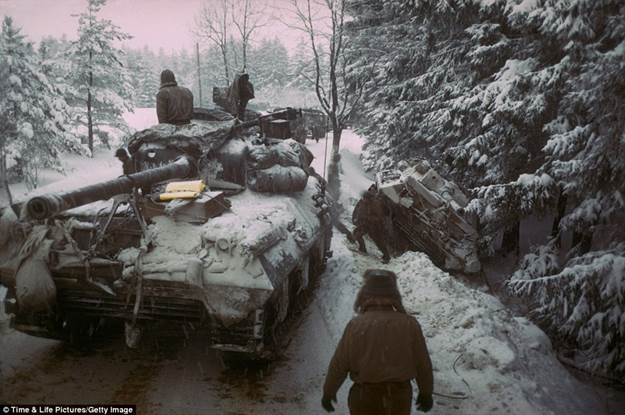
An American tank moves past another gun carriage that slid off icy road in the Ardennes Forest during a push to halt advancing German troops.p1
1944. Time/Life Collection, Ardennes Forest, Belgium. Daily Mail. Web. 20 Mar. 2014. |
Krauts ... speaking perfect English ... raising hell, cutting wires, turning road signs around, spooking whole divisions, and shoving a bulge into our defenses."
-General George S. Patton, December 17, 1944
After D-Day, the Allied forces were advancing faster than initially anticipated. However, the Allied advance from the west ran into tough resistance following a successful breakout from the Normandy Beachhead and a push through France and Belgium. Difficulties were met in the Hurtgen Forest, the ill-starred Operation Market Garden, and their dwindling supply chain, the latter reliant on temporary harbors in France and the crucial port of Antwerp.
The Situation
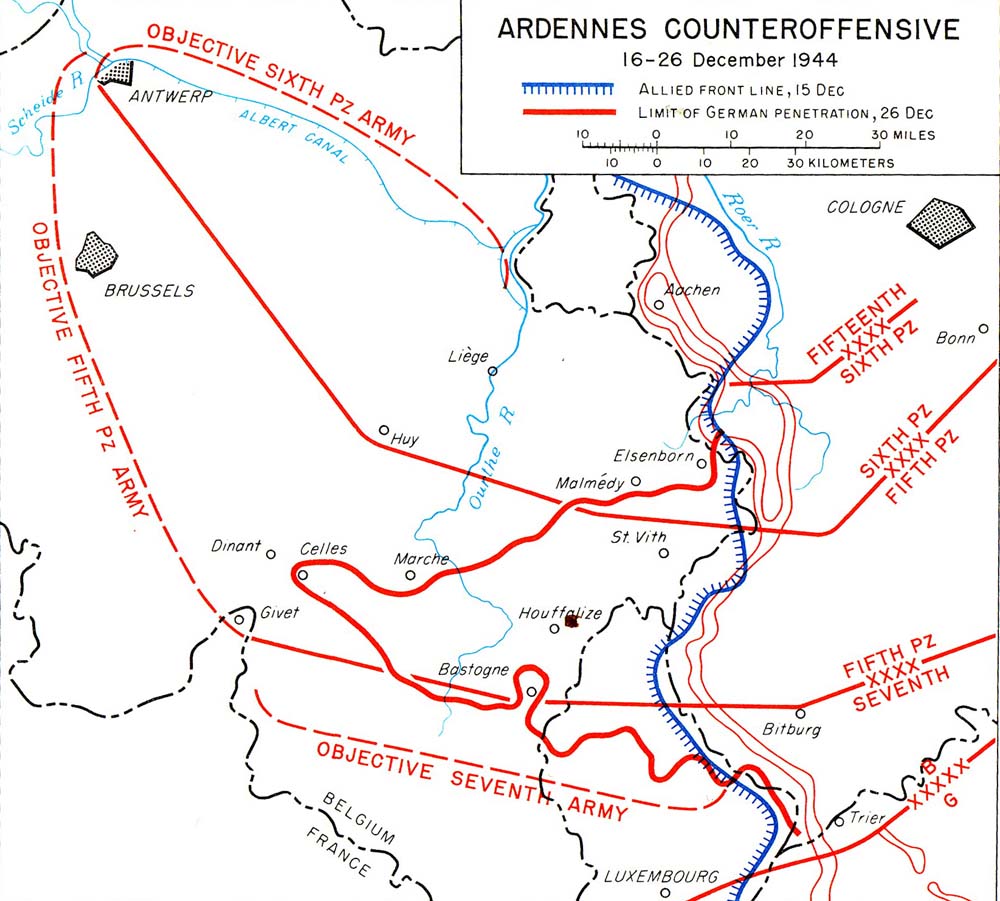
Battle of the BulgeForces converge in late December, 1944. |
Eager to duplicate the successes of 1940, when panzer formations outflanked the French Maginot Line fortifications with tanks in the same area, the German High Command authorized planning for Unternehmen Wacht am Rhein ("Operation Watch on the Rhine") to commence in early September, 1944. The goals were to assault the British and American forces, divide them, and capture the crucial port of Antwerp before defeating each force and negotiating peace with the Western allies, then turn all of their forces toward the fight in Russia. The main focus of the attack would be the American forces who were viewed as weaker than the British. It was hoped that a sufficient blow against the Americans would cause doubt on the homefront.
This was a final, risky throw of the dice, as many veteran units were pulled from the Eastern Front for this assault. The operation was planned in as much secrecy as was possible, utilizing few radio messages and moving troops at night. Despite Allied intelligence noticing numerous signs of a build-up, the information was not acted upon, and the American units in the Ardennes sector -- composed of new units depleted by prior combat -- prepared to spend a quiet holiday season. It was not to be.
The Battle
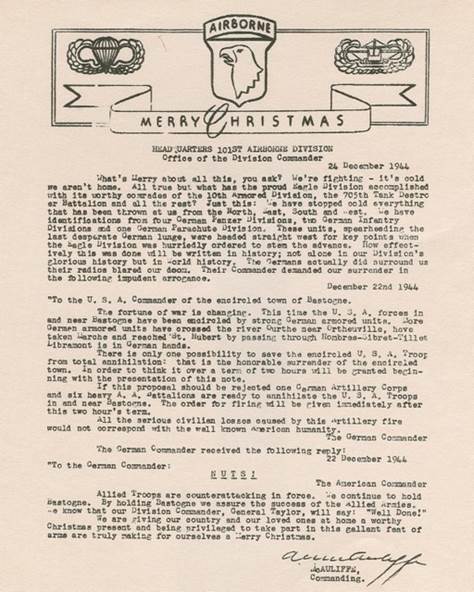
Merry Christmasp2German command requests Allied surrender at Bastogne. |
When inclement weather began in mid-December, it grounded Allied air support and reconnaissance, and the German forces struck with a massive artillery barrage. They advanced to great initial success, capturing smaller supply depots to refuel their forces. Some of the German forces included soldiers fluent in English, as well as several Panther tanks disguised as M10 Wolverine tank destroyers to further confuse the Allies.
The Germans struck hard; Panthers, Tiger I and II tanks and assault guns took a deadly toll with Allied air cover suppressed. Cold weather and the sheer surprise of the assault only made the fighting more dangerous. Many American soldiers were captured, but a few pockets of resistance, with reinforcements quickly delivered by convoys of the Red Ball Express, managed to hold out. One of the most famous of these locations was the snow-covered town of Bastogne in Belgium.
Located at a crucial eleven-road crossroads through treacherous terrain, Bastogne was key to the movements of sides, and was quickly reinforced before it was completely surrounded on December 21 by two experienced Panzer divisions and an infantry group, trapping elements of the 10th Armored division and the 101st airborne, the latter still recovering from losses.
The Turning Point
Conditions inside the perimeter were brutal. Sensing American weakness, German command requested surrender of all forces in the surrounded town.
The Americans refused.
By December 23, additional medical supplies and ammunition were air-dropped onto the town, and General George S. Patton, anticipating future orders from Eisenhower, had already moved to relieve the town.
The Aftermath
The American forces held out until Patton’s armor could relieve them, eventually bringing a closure to the bloodiest battle for the American forces in World War II, and cutting off and destroying many well-equipped German units, which were desperately needed in the East. However, World War II was far from over...
Historical Battles
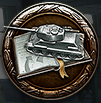 World War II brought armored vehicles to the center stage through a series of hard fought tank battles. In this never-before-seen battle mode, Historical Battles pits historic foes against each other in an all out brawl based on some of history's most intense tank encounters. For the first time, you will command historically-outfitted vehicles and compete nation-against-nation on battlefields representing historic locations. With New Frontiers come three new historically-based battles, based on: Operation Spring Awakening, the Battle of Kursk, and the Ardennes Breakthrough. Join in the melee as these locations explode in combat before you!
World War II brought armored vehicles to the center stage through a series of hard fought tank battles. In this never-before-seen battle mode, Historical Battles pits historic foes against each other in an all out brawl based on some of history's most intense tank encounters. For the first time, you will command historically-outfitted vehicles and compete nation-against-nation on battlefields representing historic locations. With New Frontiers come three new historically-based battles, based on: Operation Spring Awakening, the Battle of Kursk, and the Ardennes Breakthrough. Join in the melee as these locations explode in combat before you!
Sources
- Photo 1: Icy: An American Sherman M4 tank moves past another gun carriage that slid off icy road in the Ardennes Forest during push to halt advancing German troops.. 1944. Time/Life Collection, Ardennes Forest, Belgium. Daily Mail. Web. 20 Mar. 2014.
- Photo 2: Chambers, Richard. McAuliffe's Christmas Letter . 1944. William (Bill) Wheeler personal collection, public domain, Bastogne, Belgium. Wikipedia . Web. 20 Mar. 2014.
- Zaloga, Steve, and Howard Gerrard. Battle of the Bulge 1944. Oxford: Osprey, 2003
 |
 |
 |
